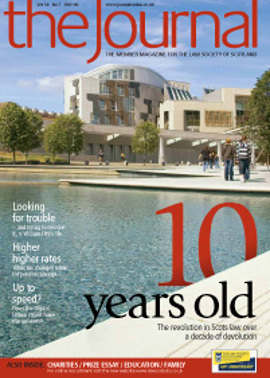Road to recovery?

The content of the Society’s Risk Management Roadshow is designed to raise awareness of the latest claims trends and risk issues affecting the profession, and promote discussion of the most effective strategies for mitigating these risks.
This year’s Roadshow sessions opened with some sobering facts and figures regarding the recent Master Policy claims experience, and some concerning emerging risks:
- the increased risk of fraud, both internal and external (as discussed in last month’s Journal article);
- increased numbers of lender claims;
- 85% of the sums paid/reserved in the current year are property/ conveyancing-related. Property/ conveyancing accounts for the highest value claim, the largest number of high value claims and the highest frequency of intimations of any area of practice.
Consequently, many of the case studies in this year’s Roadshow were property related.
“Historical revisionism”
One of the concerns currently being expressed in relation to the impact of the recession, and addressed in the Roadshow material, is that clients experiencing changed circumstances and financial pressures will be prompted to re-examine advice given by solicitors, settlements achieved and contracts documented and, with the benefit of hindsight, allege that risks should have been anticipated, that they should have been better protected, that a better deal should have been achieved for them.
Take the following scenario:
Frisk & Co acted for Mr Cleek in pursuing a claim of damages for personal injuries sustained by him in a road traffic accident. Shortly after intimation of the claim, insurers made an offer of £50,000 in settlement. Mr Cleek appeared to be recovering well from his injuries but the prognosis was uncertain. As Mr Cleek had recently been made redundant, he was keen to settle and to accept the insurers’ offer.
Two years later, Mr Cleek alleges that, since he will never fully recover from his injuries, his claim is worth at least £100,000, and he should not have accepted the insurers’ offer.
This case study was devised in response to a concern recently raised with Marsh by a solicitor. The practice had found that some insurers were making early offers to clients in personal injuries cases of a sufficient amount to tempt clients into agreeing quick settlement. Often these offers were made where no medical report(s) had been obtained. The practice’s concern was to make sure that it had advised clients fully in such circumstances, and protected its position in the event that the client accepted an offer which turned out to be much lower than could have been achieved at a later date, or, conversely, rejected an offer where the ultimate settlement ended up being lower.
To minimise the risk of a claim, or to be in a position to robustly defend a claim in such circumstances, solicitors will want to be able to demonstrate that their client was fully advised of the terms of the offer, and advised that, if they were to accept
the insurer’s offer “in full and final settlement” before the long term consequences of the injuries were known, they might be irrevocably accepting a lower settlement figure than the circumstances justify. The most effective means of achieving this is to confirm the advice in writing to the client and ask the client to sign and return a copy acknowledging the advice and confirming their instruction. Retaining clear file notes of conversations with your client which evidence their acknowledgment of your advice may be the next best option.
Instances of “historical revisionism” are not restricted to personal injury or litigation cases. The Roadshow materials illustrated a range of scenarios across a variety of practice areas, one involving allegations by a “disappointed beneficiary” that, as a result of “poor advice” given to her parents when transferring title to their home, she had received a significantly reduced inheritance. Responding to this sort of allegation will be assisted by having a clearly defined scope of engagement and a well documented file.
Break notices
The claims experience indicates that, in the current economic climate, landlords of commercial premises will more readily take advantage of the slightest deficiency in the giving of notice to exercise a break option in a commercial lease.
One of the Roadshow case studies addressed the heightened risk of a purported break notice being ineffective, and what steps could be taken to avoid this type of claim.
Humphrey & Hotspur LLP acted for Lush Developments Ltd in taking a lease of commercial premises. The terms of the lease included a break option which could be exercised at either party’s option after five years. The lease having been successfully finalised, Humphrey & Hotspur closed their file.
Shortly before the five year period was up, Humphrey & Hotspur received a letter from Lush instructing them to serve a break notice in terms of the lease. This was duly done.
Early the following week, as the fee note was about to be issued, a call was received from the MD of Lush saying that the landlord was indicating that the break notice had not been served in accordance with the terms of the lease, and was therefore ineffective.
Lush made a claim against Humphrey & Hotspur LLP for the additional rental costs they would incur now that they were bound into the lease for a further five years.
The failure of the break notice could have arisen as a result of any one of a number of defects, including:
- name (identity) and/or address of landlord incorrect. The property may have changed hands since the start of the lease
- notice not given timeously in accordance with the terms of the lease documentation;
- incorrect method of service.
This case study initiated lively discussion at each Roadshow session. Notwithstanding the successful appeal by Scottish Enterprise against Ben Cleuch Estates in 2008 (on the particular facts of this case, a break notice was held to have been validly served when received by the correct party at the correct address but in his capacity as a director of the wrong company), the strong message is that a “belt and braces” approach should be adopted to drafting and serving break notices. Risk mitigation suggestions included:
- Consider using a checklist to ensure that all the essential elements are addressed thoroughly, including the landlord, time limit, address and method for service. Check the information, and check it again!
- Confirm the identity of the current landlord (consider undertaking property searches to establish the current owner of the property).
- Where the address for service is a company’s registered office, use Companies House to verify the registered office address.
- If the firm acted for the client in relation to the lease itself, it may help manage the client if a sign-off letter issued to the client mentions the importance of allowing sufficient time for the drafting/checking of the break notice and service within the time limit.
All these checks take time, and being instructed at short notice clearly introduces an additional risk factor. Delegates made the point that last minute instructions require careful consideration. Consider whether these are instructions you wish to take on. If you do, consider how best to minimise the risks where time constraints mean that you have to rely wholly on information provided by your client. Ensure that your client is made aware of the potential implications of getting the landlord’s name or address wrong in any respect.
Lender claims
The downturn in the property market in the early 1990s illustrated how professionals (and solicitors in particular) may be the target for claims when lenders suffer losses arising out of mortgage default. Errors or omissions which would have gone undetected or caused no loss on the part of a lender while property prices were rising may become the cause of claims in the current market.
Claims by lenders very often allege breach of contract on the basis that the terms of the lender’s instructions have not been fully complied with (for example, a failure to comply with the reporting requirements of the CML Handbook). Lenders often argue that had certain facts been reported to them, they would not have proceeded with the loan.
RSA, the lead insurer on the Master Policy, contributed to the Roadshow materials a series of questions testing delegates’ knowledge of the CML Handbook reporting requirements.
Imagine you are acting for both purchaser and lender in a residential property transaction. Should you report if you discover that the property being purchased was bought by the seller three months earlier for 5% more than the clients are now paying? Should you report where the property is to be let to friends of the student child of the clients? Should you report where you become aware that the clients are receiving a cashback discount on the purchase price?
The answer is “yes” in each case. The general rules that emerged were (1) make sure you know what your CML reporting obligations are; and (2) “If in doubt, report”.
Calum MacLean and Marsh
Calum MacLean is a former solicitor in private practice who works in the FinPro (Financial and Professional Risks) National Practice at Marsh, the world’s leading risk and insurance services firm. To contact Calum, email: calum.maclean@marsh.com
The information contained in this article provides only a general overview of subjects covered, is not intended to be taken as advice regarding any individual situation and should not be relied upon as such. Insureds should consult their insurance and legal advisers regarding specific coverage issues.
Marsh Ltd is authorised and regulated by the Financial Services Authority.
In this issue
- Solicitor advocates: the future
- For the love of it
- Not to be denied
- Ten years on
- Never say never
- MD becomes new Keeper
- Whose view prevails?
- Scant relief?
- The greater good
- Twenty out of ten
- First class
- Clean break
- Ask Ash
- Not quite switched on
- Beware salary waiver tax traps
- Road to recovery?
- ASBOs: what standard?
- Scotland the unready
- The limits of listing
- Debt traps
- Tread warily
- Scottish Solicitors' Discipline Tribunal
- Website review
- Book reviews
- Procurement remedies take shape
- Clauses become more standard






